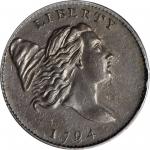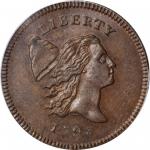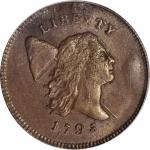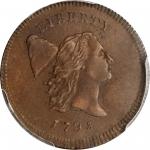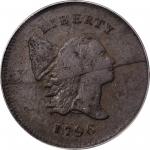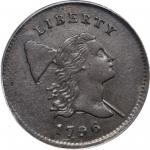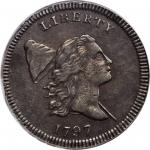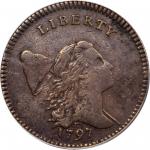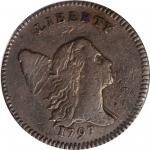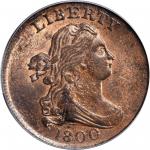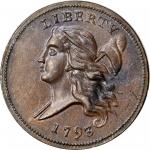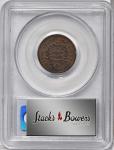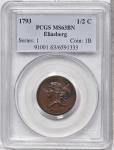1793 Liberty Cap Half Cent. Head Left. C-3. Rarity-3. MS-63 BN (PCGS). Type: Type I: Liberty Cap, Head Left.Design: Obv: A head of Liberty with flowing hair faces left, a liberty cap and pole behind. The word LIBERTY is inscribed along the upper border and the date 1793 is below. The Liberty portrait is inspired by Augustin Dupres Libertas Americana medal of 1782 -- the most famous medal produced to mark Americas victory in the Revolutionary War. Rev: A heavy wreath surrounds the denomination HALF CENT, the legend UNITED STATES OF AMERICA around the border and another expression of the denomination, 1/200, below. A ribbon knot with double bow binds the base of the wreath. The designer of the initial Liberty Cap half cent is unknown, although Walter Breen (<em>Walter Breens Encyclopedia of United States Half Cents: 1793-1857</em>, 1983) conjectures that Mint Director David Rittenhouse may have prepared the original sketches for the obverse portrait. The dies for this issue were engraved by Henry Voigt.Weight Standard: The Act of April 2, 1792, authorized the half cent at a weight standard of 132 grains (8.55 grams), but the Act of January 14, 1793, changed the weight standard to 104 grains (6.74 grams) before actual half cent coinage had commenced. According to Dr. Ronald P. Manley (<em>The Half Cent Die State Book: 1793-1857</em>, 1998) 1793 half cents that have been examined yielded weights in the range of 95 grains to 111 grains, with an average of 102 grains.Diameter: Approximately 22 mm.Die Variety: Cohen-3, Breen-3, Gilbert-1. Obv: Roger S. Cohen, Jr.s "Hooked Bust Line" variety. The digit 7 in the date is short, the letter L in LIBERTY is partly above the front of Libertys hair, and the pole is close to the end of the bust. This obverse die was also used in the C-4 pairing. Rev: There are 15 leaves in each branch of the wreath, the center dot between the words HALF and CENT is large, the digit 2 in the fraction is close to the ribbon end, and the final letter A in AMERICA nearly touches the branch stem. This reverse die was also used in the C-2 pairing.Die State: Manley reports a single die state for the 1793 C-3 variety. Obv: Perfect. Rev: Close inspection with a loupe reveals evidence of light die rust below the letters TES in the word STATES and within the wreath.Edge: Lettered: TWO HUNDRED FOR A DOLLAR, followed by two leaves.Mintage: The accepted mintage for the 1793 half cent is 35,334 coins, achieved in three deliveries:-July 20, 1793: 7,000 coins-July 26, 1793: 24,934 coins-September 18, 1793: 3,400 coinsEstimated Surviving Population for the Issue: 800 to 2,200 coins in all grades. Breen listed 21 Uncirculated survivors in his 1983 half cent <em>Encyclopedia</em>. More modern scholarship by William C. Noyes and Jack Robinson have identified just nine to 12 specimens in Mint State, respectively, which are certainly more accurate estimates than a PCGS population of 29 grading events might imply. (Third party certification data is further skewed by 14 grading events at NGC in grades from MS-60 BN to MS-66 BN.)Estimated Surviving Population for the Die Variety: Rarity-3: 200 to 600 coins in all grades. Breen knew of just six Mint State examples from the C-3 dies.Strike: Both sides are boldly struck throughout, including a fully rounded cheek on Liberty, crisp delineation between the individual hair strands, sharp veins within most of the leaves in the wreath, and so on. The impression is well centered on the planchet with broad borders outside the beads, which are also very well defined.Surfaces: This is a beautiful example of both the type and variety that offers superior surface preservation and outstanding eye appeal. Satiny in texture with plenty of rich gloss, and modest traces of semi-prooflike reflectivity in the fields, especially on the obverse. There are subtle champagne-gold and pinkish-apricot undertones to the dominant medium brown patina. A few streaks and swirls of warmer copper-gray toning are seen on both sides. Silky smooth with hardly any blemishes, a short, thin planchet flaw (as made) slanting down to the right in the lower right obverse field is the most useful provenance marker.Commentary: The 1793 half cent is significant as the first United States half cent, the only issue of the Liberty Cap, Head Left design type and one of just two denominations struck during the Mints first full year of coinage operations (the other is the large cent). Henry Voigt engraved the dies between late April and mid-July 1793, and by mid-May the Mint had already prepared more than 30,000 planchets for this issue, including having their edges lettered. All of the planchets were made from sheet copper. Actual coinage commenced on July 20 and continued sporadically until September 18. On that date the Mint also delivered the last of the Wreath cents, after which its doors closed so that employees could join the exodus of Philadelphians fleeing the yearly yellow fever epidemic that swept the city. When cold winter weather finally allowed the Mint to reopen on November 23, 1793, Robert Scot had been hired as engraver; his dies for the next Liberty Cap half cent issue -- 1794 -- featured a right facing portrait of Liberty.Given its current popularity, it may be surprising that the 1793 half cent seems to have been generally overlooked by contemporary collectors. No notable high grade pieces appeared from English or other European sources in the 20th century, suggesting that few, if any, Mint State examples were set aside by numismatists and others who visited the early United States. It was not until the 1850s that numismatics as a hobby began to gain widespread popularity in the United States and, the earliest known interest in the 1793 half cent as a valuable collectible dates to that decade. In 1855 collector Winslow Howard purchased a lot of two examples in the Pierre Flandin sale, one of the first major numismatic auctions held in the United States. Mr. Howard paid $7 for his two 1793 half cents, a sizeable sum, especially since half cents could still be found in commerce during the 1850s, at least in major Eastern cities like Philadelphia and New York. It is almost certainly the retrieval of coins from circulation during the decade preceding the Civil War that accounts for the majority of 1793 half cents extant, a theory that squares nicely with an extant population comprised almost exclusively of worn coins.Market appearances of Mint State 1793 half cents are few and far between; in the decade since 2009 we have offered only seven different Uncirculated coins through auction, including the present example. The Condition Census for the 1793 C-3 dies includes the primary and secondary Pogue specimens (PCGS MS-65 BN and MS-64 BN, respectively), as well as the Eliasberg specimen offered here. A fitting opening to our sale of the ESM Collection of Half Cents, this fabulous Choice Mint State 1793 is destined for inclusion in another world class cabinet. From the ESM Collection. Earlier from our (Bowers and Merenas) sale of the Louis E. Eliasberg, Sr. Collection, May 1996, lot 394.

